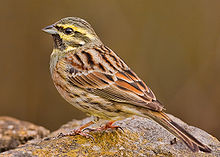- Cirl Bunting
-
Cirl Bunting 
Conservation status Scientific classification Kingdom: Animalia Phylum: Chordata Class: Aves Order: Passeriformes Family: Emberizidae Genus: Emberiza Species: E. cirlus Binomial name Emberiza cirlus
Linnaeus, 1766The Cirl Bunting (
 /ˈsɜrl/ surl),[1] Emberiza cirlus, is a passerine bird in the bunting family Emberizidae, a group now separated by most modern authors from the finches, Fringillidae.
/ˈsɜrl/ surl),[1] Emberiza cirlus, is a passerine bird in the bunting family Emberizidae, a group now separated by most modern authors from the finches, Fringillidae.It breeds across southern Europe, on the Mediterranean islands and in north Africa. It is a resident of these warmer areas, and does not migrate in winter. It is common in all sorts of open areas with some scrub or trees, but has a preference for sunny slopes.
Changes in agricultural practice have affected this species very adversely at the northern fringes of its range, and in England, where it once occurred over much of the south of the country, it is now restricted to south Devon. The Cirl Bunting is the mascot on the signs for the village of Stokeinteignhead.
Contents
Description
The Cirl Bunting is like a small Yellowhammer, 15-16.5 cm in length (wing-span 22-22.5 cm)[2] with a thick seed-eater's bill. The male has a bright yellow head, with a black crown, eyestripe and throat, and a greenish breast band across its otherwise yellow underparts, and a heavily streaked brown back. The female is much more like the Yellowhammer, but has a streaked grey-brown rump and chestnut shoulders.
The monotonous song of the cock is rattling trill, like Arctic Warbler or the terminal rattle of Lesser Whitethroat.[2]
In the summer their natural food consists of invertebrates for example grasshoppers and crickets to feed their chicks. In the winter they feed on small seeds from Over-wintered stubbles, fallow land, Set-aside, and the over-winter feeding of stock with grain or hay. They tend to feed in flocks during the winter.
The nest is on the ground, within dense cover such as that provided by thick hedgerows and scrub. The ideal scrub is said to be blackthorn, hawthorn, bramble and gorse. The breeding season runs from April until mid-September, potentially having 3 broods in total. They are sedentary in nature and will often travel only 250m from their nests to forage in summer, and up to 2 km in winter to find stubbles.
2-5 eggs are laid, which show the hair-like markings characteristic of those of buntings.
Therefore the ideal farmland habitat is a mixture of grass and arable fields, divided by thick hedgerows with pockets of dense scrub.[3]
Conservation measures within England
A very small Cirl Bunting population exists in South Devon in England.
Through its Countryside Stewardship Scheme and Environmental Stewardship, Natural England has various options to conserve the species:
- Allow stubbles to overwinter. Leave crops such as spring barley stubble untreated (no fertiliser, pesticide, or cultivation) until the end of the following March. This allows the Cirl Bunting to feed over the winter on the spilt grain and seeds of broad-leaved arable weeds like Fat Hen, Chickweed, and annual meadow grass Poa annua, which grow in the meantime. The loss of this old farming practice led to the species's decline.
- Maintain semi-improved or rough grassland and field margins, particularly tussocky grasses such as Cock's-foot. These provide an overwintering habitat for insects, which in turn provides food for the Cirl Bunting and their chicks.
- Sow barley-based wild bird seed mix crop. This crop has an open structure, allowing birds to forage.
- Delay spraying insecticides to provide invertebrate food for as long as possible.
- Leave hedgerows untrimmed for periods of time. This provides breeding areas and food.[4]
A partnership between Natural England and the RSPB runs the "Cirl Bunting Project", part of a larger project called "Action for Birds".
Through the efforts of conservation organisations and landowners, the Cirl Bunting population has increased from 118 pairs in 1989 to 700 pairs in 2003. However, their range has not expanded.
References
- ^ The RSPB: Projects: The Cirl Bunting Project
- ^ a b The Birds of the Western Palearctic [Abridged]. OUP. 1997. ISBN 019854099X.
- ^ Farming for Birds Cirl Bunting RSPB leaflet
- ^ Entry Level Stewardship Handbook. Natural England. 2008. p. 29. ISBN 978-1-84754-080-5.
- BirdLife International (2004). Emberiza cirlus. 2006. IUCN Red List of Threatened Species. IUCN 2006. www.iucnredlist.org. Retrieved on 12 May 2006. Database entry includes justification for why this species is of least concern
External links
- ARKive Stills, video]
- An RSPB guide to Cirl Bunting sites in Devon. Retrieved 18-5-2007.
- Ageing and sexing (PDF) by Javier Blasco-Zumeta
- [1]Natural England and RSPB Cirl Bunting Project
- [2]RSPB, Natural England, Paignton Zoo Cirl Bunting Re-introduction Project
- RSPB website description, including song
- Overwinter Stubbles Advice for Farmers RSPB website
Categories:- IUCN Red List least concern species
- Emberiza
- Birds of Africa
- Birds of Europe
- Birds of Algeria
- Birds of Egypt
- Birds of Iran
- Birds of Morocco
- Birds of Tunisia
- Birds of Turkey
Wikimedia Foundation. 2010.

